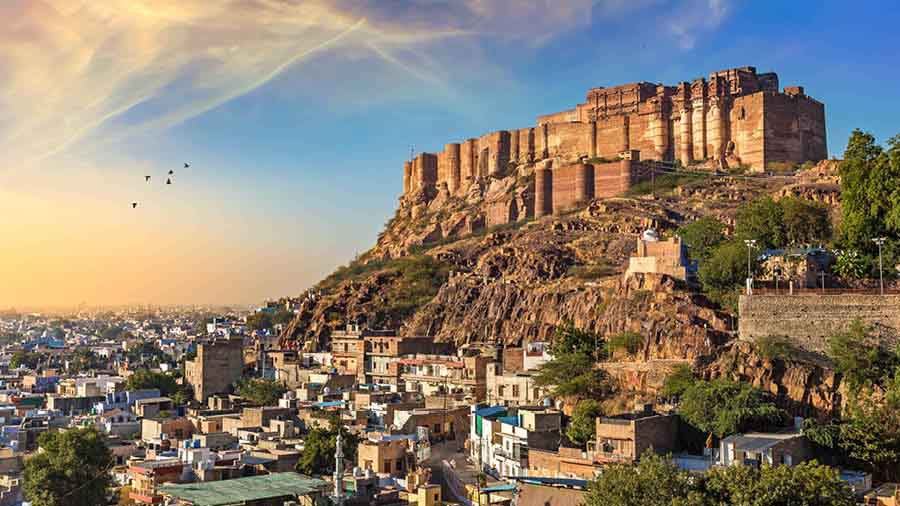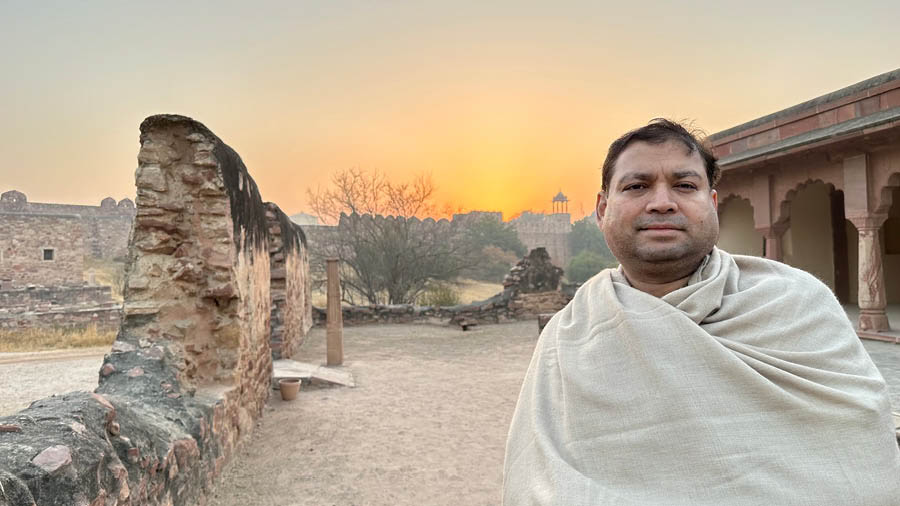Rudyard Kipling had called it “a palace that might have been built by Titans and coloured by the morning sun”. Historians have dubbed it as the most impregnable citadel of Rajasthan, which even the Mughals could not lay siege upon. For an engineer, it is a masonry marvel, whose imposing walls seem to have grown straight off a stony outcrop. To the discerning traveler, Mehrangarh Fort of Jodhpur is an intricate tapestry of half a millennium of history and artistry, intertwined with valour, sacrifices and secrets.
In 1460, Rao Jodha, a Rajput chieftain, decided to shift his base from nearby Mandore to a craggy hilltop on the eastern fringes of the Thar desert. The elevated base would be a strategic location to get an advance notice of invading armies.
A hermit named Cheerianathji (lord of the birds), had made this hillock his base with a large avian fleet. The king’s relocation displaced the saint and a furious Cheerianathji cursed Rao Jodha that his new fortress would forever suffer from droughts.
A deflection of the curse was crucial, and the king persuaded Raja Ram Meghwal, a commoner living in the vicinity, who agreed to be buried alive into the very foundations of the Mehrangarh Fort in return of a grant of land to his family for perpetuity.
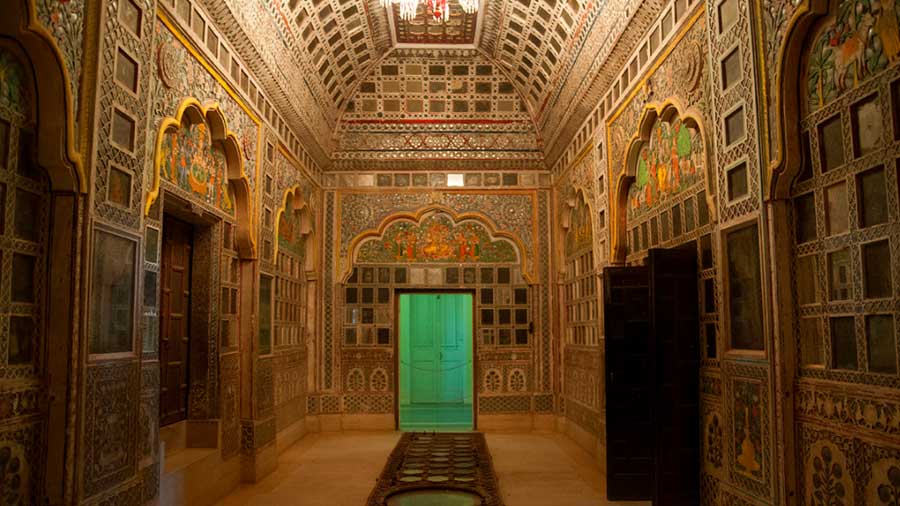
An ornate chamber inside the fort Sugato Mukherjee
Winding up the steep gradient of the road that leads to the grand entrance of Jai Pol, you can imagine the chequered history of Mehrangarh written on the age-worn stones and on the cannonball marks on the perpendicular, windowless walls: a murky tale of invasions and political intrigue in medieval times. And then you reach a rust-coloured plaque, marked with a wreath that commemorates Raja Ram Meghwal’s supreme sacrifice. A moment of quiet reflection as you enter the inner recesses of the grand citadel.
In the journey into the depths of Mehrangarh’s storied past, your constant companion is the audio guide. The deep baritone, accompanied by bugles and drums, chaperones you through the fort’s many mahals and museums. The palaces, built over five centuries, are linked by expansive courtyards buzzing with streaming visitors and a fleet of pigeons constantly flitting across the open spaces. The caretakers of the palaces, attired in white salwar suits, with saffron sashes draped around their waist and colourful turbans, provide a static counterpoint amid this chaotic din, and serve as a throwback to the regal past.
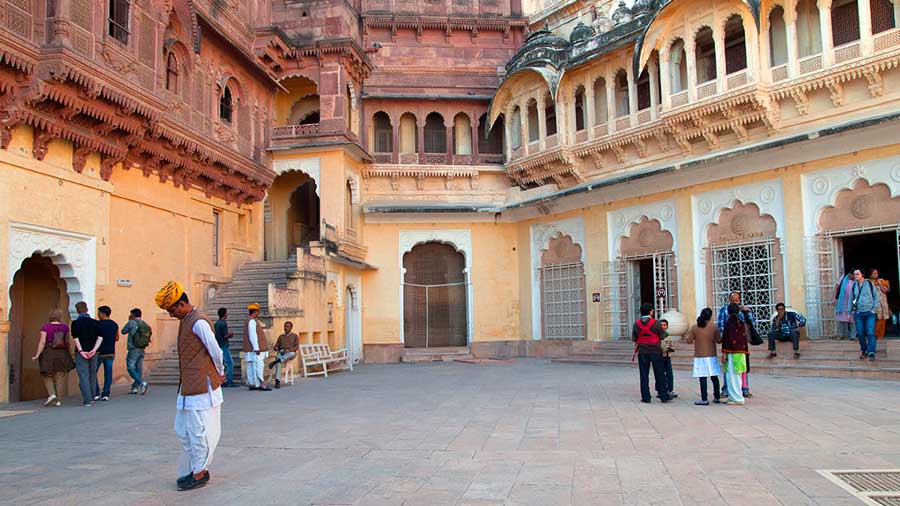
A courtyard in Mehrangarh fort Sugato Mukherjee
Mehrangarh has seven pols or gates, each heavily fortified. Just beyond the Suraj Pol lies the Coronation Courtyard (Shangar Chowk), where the Rathore rulers of the kingdom of Marwar was crowned on an elegant marble throne. The detailed lattice work of the sandstone windows that almost entirely covers the surrounding walls sets your imagination run free: you can visualise royal women, restricted by the pardah system, but still curious to have a glimpse of the royal coronation ceremony, peering through the chinks of the stone-crafted windows on the courtyard below.
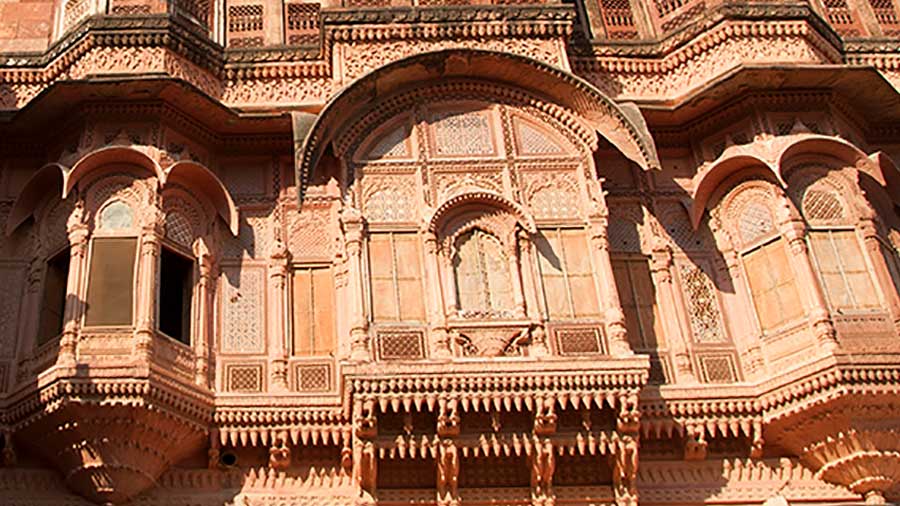
The sandstone windows, looking down on the courtyard below Sugato Mukherjee
The adjacent royal chambers have been converted into impeccably maintained museums, housing the exquisite possessions of the Rathore dynasty. It is a veritable treasure trove of royal artefacts, solid silver hawdahs (elephant seats) and assorted armaments including Emperor Akbar’s sword and Timur’s scimitar. The room upstairs showcases some of the finest Rajput miniature paintings.

A collection of royal clocks in the museum Sugato Mukherjee
The magnificent Phool Mahal (Flower Palace), with dazzling stained-glass windows and gold filigree ceiling, was a pleasure chamber of the royals hosting musical soirees and poetry sessions. The 19th-century Takhat Vilas is another ornately decorated chamber, with a curious mixture of paintings of Hindu deities and European ladies; a style reflected in the nearby Sheesh Mahal (Palace of Mirrors), where the panels under the arches depict Hindu mythological scenes, while European glass chandeliers hang from the wooden ceiling. The 16th-century Moti Mahal (Pearl Palace) had been the Hall of Councils, holding conferences between the king and his advisories. The five alcoves in the lustrously polished wall opposite the entrance are in fact concealed balconies where the queen would secretly listen on the proceedings of the meetings and later give her advice to her husband.

The ornately crafted Phool Mahal, designated for princely pleasures, inside the fort Sugato Mukherjee
Zenana Deodhi, or the women’s quarters, unsurprisingly, are a little claustrophobic with tiny chambers. One of them served as the royal birth room that saw a curious ritual over five centuries – the midwife would drop a lemon to the ground below to announce the arrival of a new royal.
The most haunting tale of Mehrangarh is scripted on the stone walls of Loha Pol. A number of reddish imprints of little palms carved on the wall tell a tale of the women of the fort who immolated themselves after the king suffered a heavy defeat in a battle with the neighbouring kingdom of Jaipur in 1843.

The expanse of the blue maze of the old city from the ramparts of the Mehrangarh Fort Sugato Mukherjee
The final stop of your journey through the cultural and architectural extravaganza that is Mehrangarh would be the crest of this majestic citadel. From up there, the maze of blue that expands to the border of the Thar desert looks magnificent. It is Brahmapuri, a cluster of blue-tinted houses and an intricate network of labyrinthine alleys: the neighbourhood is as old as the citadel and one that has earned Jodhpur its famous sobriquet – the Blue City.
Sugato Mukherjee is a Kolkata-based journalist with bylines in the BBC, Al Jazeera, Deutsche Welle, Nat Geo Traveller and several inflight magazines. Sugato’s coffee table book on Ladakh received critical acclaim, and his documentary work on sulphur miners of East Java was recognised by the UNESCO.
